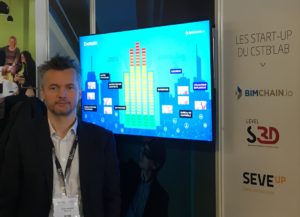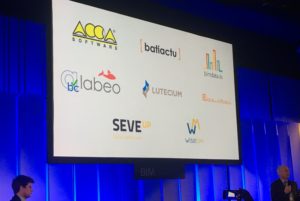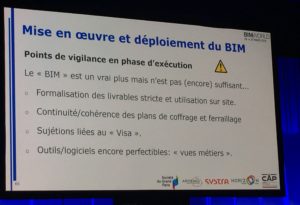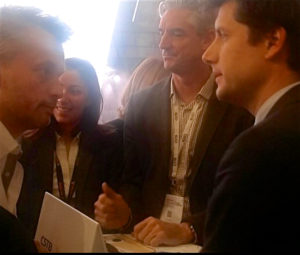 2 full pages about BIMCHAIN.io in the news in June published in the same time. An article from Stephen Cousins in BIM+, et one from Julie Nicolas in Le Moniteur.
2 full pages about BIMCHAIN.io in the news in June published in the same time. An article from Stephen Cousins in BIM+, et one from Julie Nicolas in Le Moniteur.
(If you read French and want to read it for free, you can click here !)
 2 full pages about BIMCHAIN.io in the news in June published in the same time. An article from Stephen Cousins in BIM+, et one from Julie Nicolas in Le Moniteur.
2 full pages about BIMCHAIN.io in the news in June published in the same time. An article from Stephen Cousins in BIM+, et one from Julie Nicolas in Le Moniteur.
(If you read French and want to read it for free, you can click here !)
BIMCHAIN.io attends DIGIBAT on June 14th, focusing on Digital & Construction.
The city of Laval welcomes this event, a mix of conferences, workshops, business meetings, and exhibitions.
We conduct a workshop at 4.45pm, ‘BIM & Blockchain’ , and you’re very welcome, this is a free event, you can attend by clicking the link below
We will be there too, at this annual ‘Tech Ceremony‘ , namely Vivatech! Prepare your organic energy bars for this marathon 
that will mix conferences, demo, pitchs, hackhathon – and overall prepare in advance a well-defined schedule. Ours is simple: to meet you, Thursday 24 and Friday 25, at our stand BIMCHAIN.io J30-018, at the RATP Group village who welcomes us. I need to disappear 2 hours however, to attend these two conferences: Joe Lubin’s talk, co-founder of Ethereum who has just opened a Consensys office in Paris , and Tristan Harris’ , who will bring Ethics and Humanity among this “all for tech” . I hope to see you too!
We have been selected by Impulse Partners to integrate their Lab‘, and this is very good news. This is very good news because, in addition to having convinced a jury of industry experts, we will benefit from a network of the 50 largest corporate companies in France, and a gateway to the United Kingdom. We were made to meet, it’s done !
and this is very good news. This is very good news because, in addition to having convinced a jury of industry experts, we will benefit from a network of the 50 largest corporate companies in France, and a gateway to the United Kingdom. We were made to meet, it’s done !
Beautiful meetings on our BIM World stand shared with the CSTB Lab’ , and exciting discussions on how BIMCHAIN.io will help for example:
, and exciting discussions on how BIMCHAIN.io will help for example:
A-BIME to protect copyrights in the renovation of historic buildings
SNCF Réseau to follow the life cycle of materials used form within the digital model.
Bouygues to engage directly from the model in construction phase on a sub-part of the folder only, as a floor or a facade.
And especially two strong events:
The opening of the collaborative platform of the PTNB: KROQI
“Collegially we all have an interest in taking the step,” said Julien Denormandie,  Secretary of State for Cohesion of the Territories, with the ambition to benefit the SME / Craftsmen of the BIM revolution.
Secretary of State for Cohesion of the Territories, with the ambition to benefit the SME / Craftsmen of the BIM revolution.
LUTECIUM announced as partner of the PTNB to integrate BIMCHAIN.io to KROQI.
The Conference: BIM and the Grand Paris Express
“The major problem of the BIM is that the model is not contractual.The collaborative framework is hampered by a real difficulty of contract management that prevents full exploitation of the” data centrism “of the digital model”  dixit Nicolas Lefort, BIM Manager for the SGP.
dixit Nicolas Lefort, BIM Manager for the SGP.
All the processes – technical control, architect’s visa, procurement – continue to operate on traditional deliverables, ie 2D paper plans, extracted or not from digital models. In this context, what is the purpose of the model?
Cirectly contracting the digital model as proposed by BIMCHAIN.io makes it possible to reduce – or even eliminate – all these “paper” deliverables – and especially to give it back its central database role to all processes.
A year ago, Maxime and I were at the BIM World, actively browsing stands and conferences, to understand the maturity and the adoption process of the industry.
 Few months later, we designed BIMCHAIN.io, the Blockckhain solution to accelerate the BIM revolution.
Few months later, we designed BIMCHAIN.io, the Blockckhain solution to accelerate the BIM revolution.
This year, we’re proud to be part of the BIM World, exhibitor at the booth 141 of the CSTB Lab ‘: come and talk with us to understand why the Blockchain is the key to the dematerialization of contracts and commitments, and the trusted environment that BIM needs.
See you March 28-29 at La Défense – we have invitations for you: be among the first 10 to send us a mail with your last name and first name !
We were invited in February to the BIM Master of ESTP to discuss with the students the potential contribution of Blockchain to the BIM, and our solution BIMCHAIN.io.  A session scheduled for one hour which finally stretched over two as the hearing was so sharp ! Discussions of various types, on the granularity of data and the ability of software to manage objects, the maturity of the administration in term of dematerialization. But also Ethereum killers, ICOs, transaction price calculations, ecological impact of Proof of Work … Intense ! Thank you Kevin for the invitation and to all for this moment.
A session scheduled for one hour which finally stretched over two as the hearing was so sharp ! Discussions of various types, on the granularity of data and the ability of software to manage objects, the maturity of the administration in term of dematerialization. But also Ethereum killers, ICOs, transaction price calculations, ecological impact of Proof of Work … Intense ! Thank you Kevin for the invitation and to all for this moment.
 One should ask about who owns the digital model built by everyone in a collaborative mode, and the BIM protocol rarely addresses the legal problems of the Intellectual Property in that process. Anne-Marie Bellenger and Amélie Blandin ask in their book “le BIM sous l’angle du droit” (“BIM from a legal point of view”) for the BIM protocol to be clear and precise (…) in the distribution of tasks between the different actors in order to secure the identification of each other’s respective obligations and related responsibilities.”
One should ask about who owns the digital model built by everyone in a collaborative mode, and the BIM protocol rarely addresses the legal problems of the Intellectual Property in that process. Anne-Marie Bellenger and Amélie Blandin ask in their book “le BIM sous l’angle du droit” (“BIM from a legal point of view”) for the BIM protocol to be clear and precise (…) in the distribution of tasks between the different actors in order to secure the identification of each other’s respective obligations and related responsibilities.”
Transmitting data from multiple authors to a single shared document (the digital model) is legally complex, as it challenges conventional contractual commitments between disciplines. Transmitting the right to use the digital model is no less problematic.
The report “Droit du numérique & bâtiment” (Digital Rights & Building) as part of the French Digital Transition Plan in the Building (PTNB) is explicit on that topic.”The digital model mixes a large number of intellectual property rights: know-how, copyrights, patents, designs and models, trademark rights, database rights but also contributors and therefore contributions from these last.”
And this report describes precisely “three types of regimes when several actors contributes“:
1. “The composite work is a new work in which is incorporated a pre-existing work without the collaboration of the author of the latter. The author of the first work is thus not the author of the composite work.””The last contributor of the model only will have the ownership rights on the digital model.“It is the result of a collaborative work of BIM level 2 where each contributor, author of his model, participates in the composition of a federated global model whose project management is the final author.
2. “The collective work is a work created on the initiative of a person who edit it, publishes it and discloses it under his direction and in his name.””The collective work would then be the property of the natural or legal person under whose name it is disclosed, that person would be invested with copyrights.“It comes from a collaborative work between the BIM level 1 and level 2 where a person (the BIM manager for example) is the author of the digital model by modeling on behalf of other stakeholders.
3. “The collaborative work is a work on which several authors have worked. The authors worked together to develop the work in such a way that it is impossible to accurately determine the contributions of the various authors. “”In the case of a collaborative work, each of the authors, if he furnishes proof of his collaboration, is invested with copyright in the work in co-ownership.””In our opinion, this collaboration scheme is very difficult to manage because of the many authors of the digital model, which could thus block the exploitation of the model in its entirety, especially in a later phase where data from the model would be used.“It comes from a collaborative work of BIM level 3 where each actor contributes simultaneously on a shared central digital model.
“The need to go through a contracting process is therefore stronger, to avoid having one of the authors blocking the exploitation of the model. “ What Olivier Celnik confirms in the preface to the book “BIM from a legal point of view“: “Following the conclusions of the Pican report, we admit that BIM has a contractual essence , not a legal follow the law but the onctract is called to be essentially contractual, and not legal: it is not the law that will set a unique and rigid framework but, on the opposite, the contract that must take into account the specificities of each project, with its context and its actors.”
This new traceability technology brings a relationship of trust between the multiple actors of construction by proving their interventions on the digital model. For each document exchanged, the blockchain is able to create an identifier, a unique digital signature, and to anchor its personal contribution timestamped in the chain of interventions that allow to model together the digital model. It is therefore possible to completely trace the chain of participations (data and documents) and thus ensure and protect all contributions of stakeholders in the digital model by prior art. Tomorrow, with BIMCHAIN.io, everyone will leverage the Blockchain capacity to protect his rights easily and in full transparency. The contract of co-ownership of the digital model is clear and can be used with confidence during the entire life cycle of the building.
After a brief meeting at the inauguration of CSTB Lab ‘in October, we had more time this time  at Batimat’ for a real ‘face to face’! debate with French Minister Julien Denormandie about Blockchain’s potential in the Construction business – and of the immediate value added from BIMCHAIN.io. If the legal value of Blockchain has been recognized in the French “Code Monétaire et Financier” in 2016, why should the “Code de la Construction” – apparently in revision mode – not follow in 2018? To be continued …
at Batimat’ for a real ‘face to face’! debate with French Minister Julien Denormandie about Blockchain’s potential in the Construction business – and of the immediate value added from BIMCHAIN.io. If the legal value of Blockchain has been recognized in the French “Code Monétaire et Financier” in 2016, why should the “Code de la Construction” – apparently in revision mode – not follow in 2018? To be continued …
At Lutecium, we’re pretty happy to be among the first 6 winners to join the CSTB Lab’, which is convinced that we can help to make BIM successful in France and abroad thanks to BIMCHAIN.io. We look forward to working with CSTB and Impulse Partners to accelerate our growth.

And congrats also to Seve, Snapkin, Levels3D, XTreeE, Syscobat !